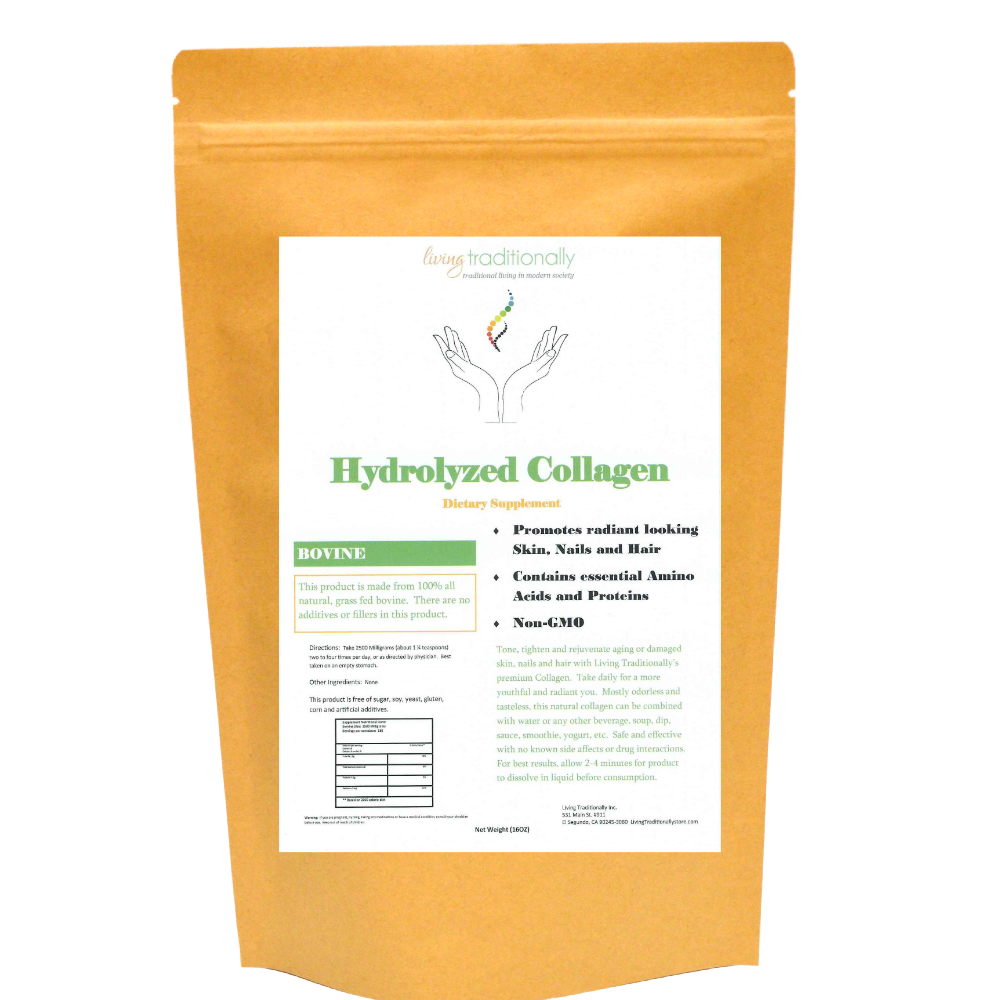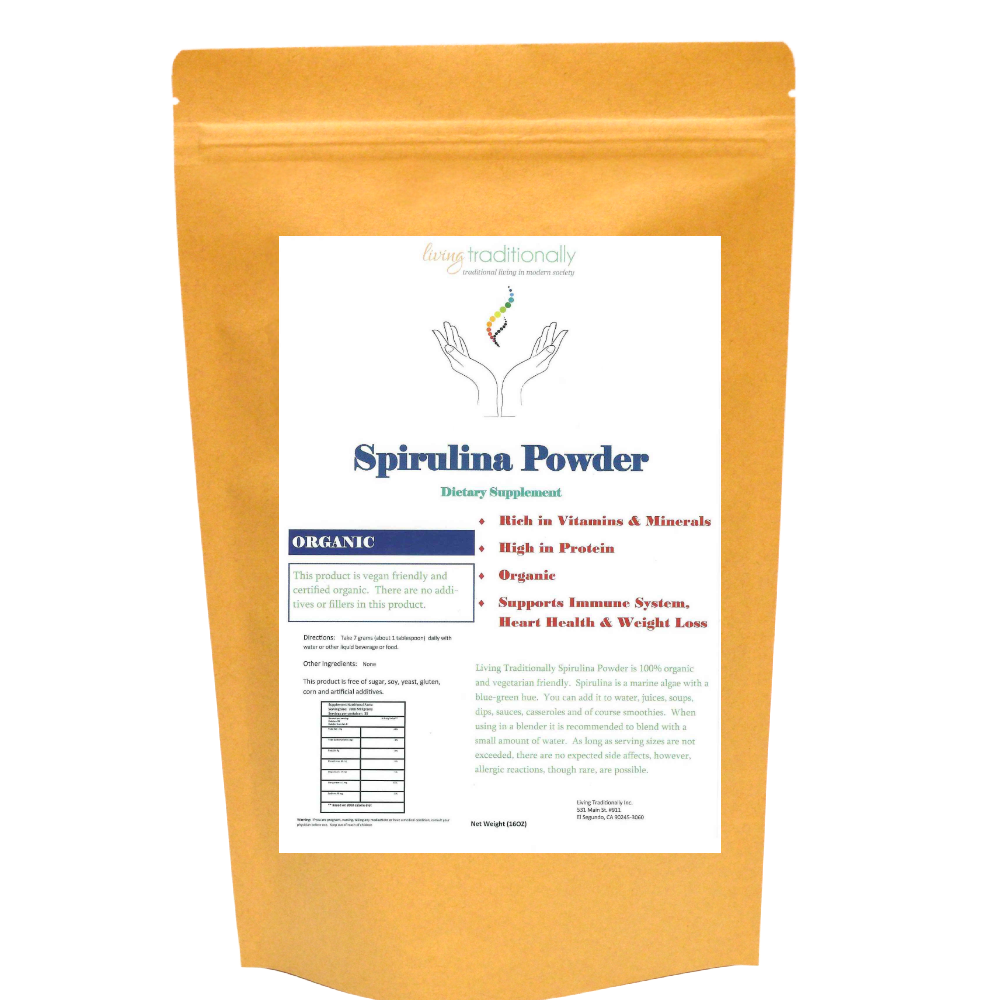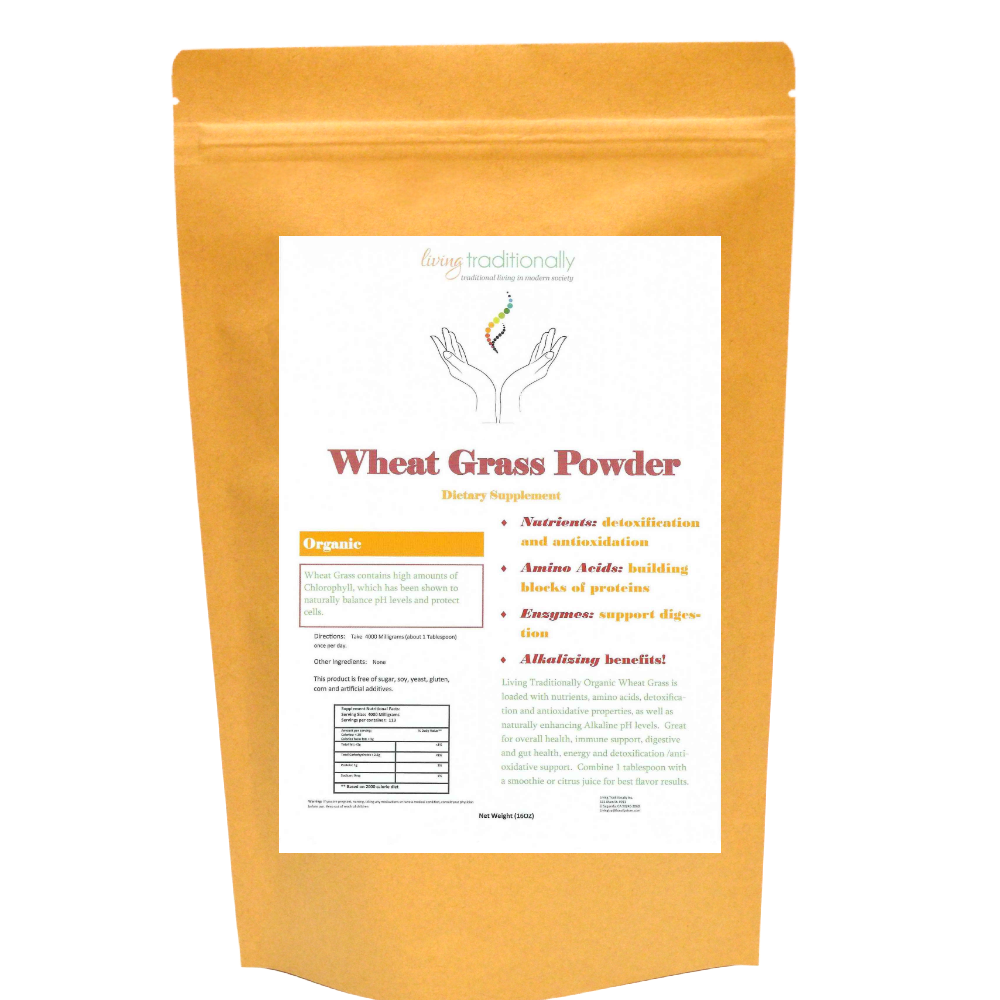Why We Age - and what we can naturally do about it
Posted by Living Traditionally Inc. on Aug 28th 2018
Introduction: The Skin is the Largest
Organ
You have probably heard the saying “you are what you eat”, well it goes even
further “you are what you put on your skin”. As you know, our skin is the
largest organ of our body and there is more danger in putting chemicals on your
skin than actually consuming them! Why? Because our skin can breath and thus
absorbs the things we put on our skin. If we just use conventional body care,
our skin is absorbing nothing but dangerous ingredients. SO, what happens next?
These toxic ingredients enter our bloodstream and get carried around our body,
penetrating our organs. Our skin absorbs 60% of what is put on it. It goes from
the skin to the bloodstream and is delivered to all body parts. Remember, our
skin is very gentle and sensitive, so treating it right is detrimental to the
process of skin aging.
Skin Facts
To take the best care of your skin, it’s very crucial to understand its
structure.
Our Skin is a living system of nerves, cells, and capillaries. It is made up of
three layers: the epidermis, dermis and hypodermis.
The epidermis is the outermost and thinnest layer. It creates a barrier between
our inner and outer worlds. It is very thin like paper but tough. The epidermis
has three sub-layers: the stratum corneum, the squamous cell layer and the
basal cell layer. It approximately takes a month for skin cells to move from
the basal cell layer to the top of the stratum corneum and slough off. The
epidermis is made up of cells called keratinocytes, which are piled on top of
each other, forming various sub-layers. The keratinocytes form at the bottom
and rise to the top, where they are fall off from the surface as dead
cells. This means that the epidermis is constantly renewing
itself.
The condition of epidermis determines how good your skin looks and how well it
absorbs and retains moisture.
The dermis is the second layer and is the thickest of the skin layers
containing the collagen and elastin fibers that create the flexibility and
firmness of skin. The dermis is made of elastic, flexible connective tissue
that create strength and smoothness of the skin. Collagen – provides
support to the skin. Fibroblast cells are responsible for manufacturing
collagen. Elastin gives the skin elasticity. The dermis nourishes and supplies
blood to the epidermis. The dermis also contains hair roots, sebaceous glands,
sweat glands, receptors, nails, blood vessels, and mechanoreceptors. Wrinkles
appear and develop in the dermis. This means that anti-wrinkle creams have to
penetrate deep into the dermis in order to be effective. Unfortunately,
most collagen and elastin creams are ineffective because they never reach the
dermis. The reason for that - collagen and elastin molecules are too large to
penetrate the epidermis.

The subcutaneous layer, the deepest layer of skin, is mostly made up of fatty
tissue. It also contains blood vessels and nerves. It protects internal
organs and helps to insulate the body by monitoring heat gain and heat loss.
The hypodermis is made of a connective tissue called adipose tissue that stores
excess energy as fat. Blood vessels, lymph vessels, nerves and hair follicles
also run through this layer of skin. It also plays a very important role on the
way the skin looks. As the age, we lose the subcutaneous tissue that leads to
sagging and wrinkles. A standard procedure performed by dermatologists to
prevent this process is to inject fat (taken from other areas of your body)
under the wrinkles on the face.
Skin is not only the largest organ of your body, it is also the most
vulnerable. The primary function of the skin is to defend our bodies from
external toxins and bacteria. So, if you put nothing but toxins onto your skin,
it will slowly lose its ability to protect. Thus, using the natural antioxidant
rich nourishing ingredients will help boost your skins primary function.
Why We Age
With each day we get a little older: aging of the skin and the whole body is
inevitable. However, in some degree, you can control the speed and the effect
of the aging process if you know and follow certain rules of what to eat, how
to exercise, and what to avoid.
A free radical is any atom or molecule that has a single unpaired electron in
an outer shell which makes it very unstable and reactive. When cells in the
body come across with free radicals, the reactive radicals may cause
destruction of the cell. Since these molecules are very unstable, they are
always searching for that extra electron. When they come across the
complete molecule, they steal the extra electron, making the stable molecule
into a free radical. According to Dr. Harmon, who discovered the free radical
theory of aging, “cells continuously produce free radicals, and constant free
radical damage eventually kills the cell. When free radicals kill or damage
enough cells in an organism, the organism ages.”
The fact is that over time, our bodies accumulate various toxins that promote
the destruction of cells of the skin. Accordingly, in order to slow the aging,
it is necessary to prevent accumulation of these substances. Poor diet and
unhealthy lifestyle heavily contribute to the aging process that makes it
harder to repair cellular damage. First, to avoid the formation of free
radicals, you need to build the right diet. You need to eat antioxidant rich
foods that will help to get rid of the free radicals that affect aging and
deterioration of the skin. Antioxidants found in food can absorb free radicals
before they create cellular damage. Therefore, since our skin is the largest
organ of the body putting the antioxidant rich ingredients onto our skin, will
help fight the damage associated with free radicals.
Skin is The Reflection of Internal Beauty
Many people spend a lot of money on expensive antiaging creams and various skin
treatments. To get your skin to be healthy and youthful, you must nourish your
skin from within. Skin is the direct reflection of what is going on inside your
body. The truth is that no expensive cream can do for your skin what a healthy
lifestyle can. Eating right and using only natural ingredients on your skin,
will slow down the rapid aging of the skin making it younger at any age.

Nutrition For Skin
Radiant, youthful skin is the direct result of healthy living and not expensive
creams. Eating a well-balanced diet that consists of real food and excludes
processed foods helps insure that your body gets all the vitamins it needs to
maintain healthy skin. Since our bodies are always in a cleansing stage,
supplying the right nutrients to our cells, should be the priority. As we know,
our skin is made of collagen and elastin which tend to relax with age and, and
as a result, form wrinkles. It is important to rebuild collagen by consuming
foods high in anti-oxidants and vitamins.
Nutrients for healthy skin
Vitamins A, E, and C improve the synthesis and regeneration of collagen and
help maintain healthy, smooth skin.
Vitamin A
Vitamin A promotes proper repair and maintenance of the skin. It helps skin
cells mature and enables them to fight infection. Vitamin A is collected by the
fat under the skin and is released when is needed.
Deficiencies in Vitamin A can result in a dry, flaky complexion. Topical
vitamin A treatments (food based) are often used to treat acne and other skin
ailments.
Foods high in vitamin A include liver, eggs, dandelion, carrots, apricots, collard
greens, kale, sweet potatoes, pumpkin, carrots, spinach, and cantaloupe.
Vitamin C
Vitamin C plays a vital role in the synthesis of collagen and elastin. It’s a
miracle Vitamin for the skin. Vitamin C improves skin firmness by triggering
collagen production. Vitamin C helps to repair the damage caused by external
factors. It also improves the skin's texture and tone.
Vitamin C is a potent antioxidant that fights free radicals responsible for
skin aging and dryness. According to the latest scientific research, Vitamin C
leads to a more effective skin regeneration and protects the skin from DNA
damage. http://www.eurekalert.org/pub_releases/2009-09/uol-srn090909.php)
Vitamin C combined with Vitamin E is effective at protecting the skin from
overexposure to the sun.
Foods high in vitamin C: bell peppers, kale, parsley, collard greens,
turnips, broccoli, guava, strawberries.
Vitamin E
Vitamin E is one of the most effective anti-aging vitamins to reverse the aging
of skin. It's a fat-soluble vitamin that is able to slow down aging. Vitamin E
protects cell walls and regulates collagen breakdown. It's a defender for
our skin. Our bodies store vitamin E in our fat cells. However, your body can't
produce it, which means you have to make sure you're getting enough of this
valuable nutrient in your diet.
Vitamin E also boosts your skin's resistance to UV damage. Acts as
antioxidants, which helps your body of harmful toxins that reduce the effects
of your anti-aging efforts. Vitamin E can also be used topically to clear or
reduce skin scars. It soothes dry or rough skin. Vitamin E combined with
selenium improves glutathione levels in the body, thus increasing antioxidant
activity.
Foods high in Vitamin E: organic free-range eggs, avocados, sunflower seeds,
almonds, pine nuts, spinach, cabbage, asparagus, turnip greens, chard, brussels
sprouts, broccoli, olives, paprika, prunes.
Selenium
Selenium is one of the most important trace minerals with amazing health
benefits. Selenium is an antioxidant mineral responsible for tissue elasticity.
Researchers discovered that selenium was an essential component of the
glutathione peroxidase enzyme system. Glutathione peroxidase's main biological
role is to protect the organism from oxidative damage that causes aging,
inflammation, and even skin cancer. It acts to prevent cell damage by free
radicals. In this role, selenium complements the anti-oxidizing function
of vitamin E. Vitamin E and selenium help to enhance the effect of one another.
It may play an important role in preventing skin cancer, as it can protect the
skin from damage from excessive ultraviolet light.
Foods high in selenium: seafood (salmon, sardines, tuna), organ meats, beef,
lamb, turkey, brazil nuts.
Silica
Silica is a trace mineral that strengthens the body's connective tissues and is
important for healthy skin. Silica is also called "beauty mineral"
because it improves skin elasticity and helps with hair and nail growth. Silica
supports collagen production. It helps reduce and eliminate skin problems such
as acne, age spots, eczema. Silica is also refereed as the skin's glue as
it holds us together. Silica is also a natural detoxifier. It helps get rid of
toxins and pathogens.
Silica deficiency can result in reduced skin elasticity and can affect the
body's ability to heal wounds.
Foods high in silica: leeks, green beans, strawberries, cucumber, mango,
celery, asparagus and rhubarb.
Horsetail is one of the richest plant sources of silica known to mankind.
Pantothenic acid (B5)
Pantothenic acid, also called vitamin B5, is a water-soluble vitamin which acts
as a natural skin protector and healer. It contains natural abilities to
regenerate the skin. Pantothenic acid is a part of many biological activities
and is required by various types of skin cells for proper regeneration.
Vitamin B5 acts as a humectant, stabilizing the skin barrier function.
It reduces the amount of water lost through the skin. Pantothenic acid is
able to penetrate deeply into the dermis and keeping moisture
underneath the surface of the skin. Pantothenic acid also boosts the levels of
glutathione in the cells, which act as a potent antioxidant in the skin.
Pantothenic acid helps the skin maintain optimal health and promotes healing of
tissues.
Foods high in Vitamin B5: liver, kidney, egg yolk, sweet potatoes, broccoli,
avocado, mushrooms, shellfish.
Vitamin B1 (Thiamine)
Vitamin B1, also known as Thiamin/Thiamine helps with metabolizing
carbohydrates and the generation of energy. Vitamin B1 is necessary for normal
nerve functioning and is essential for many cellular processes. is responsible
for circulation. It gives skin a healthy glow. Vitamin B1 is a powerful antioxidant,
which helps eliminate and protect from the signs of aging like wrinkles
and age spots.
Foods high in Vitamin B1: organ meats, yeast, egg yolks, raw vegetables
and fruits, nuts.
Riboflavin (or B2)
Riboflavin, or Vitamin B2, is a water-soluble vitamin which functions to help
body cells create energy from the metabolization of carbohydrates, protein, and
fat. Riboflavin plays an important part in protecting your body from damage
caused by free radicals and consequently premature aging and many chronic
diseases. Riboflavin serves as a component of the enzyme glutathione
reductase, which shields your body from free radical damage. Glutathione is a
small molecule that is responsible for helping prevent the oxygen-based damage.
It must be constantly recycled, and it is vitamin B2 that allows this recycling
to take place. Vitamin B2 is incredibly beneficial for healthy skin. Riboflavin
helps to improve the secretion of mucus in the skin, which aids in preventing
and treating skin problems such as dermatitis and eczema.
Foods high in Vitamin B2: Beet greens, spinach, asparagus, cremini mushrooms,
eggs.
Vitamin B12
Vitamin B12 (Cyanocobalamin) is the ruler of cell metabolism, it controls
cell formation and cell life span. It's essential for proper functioning
of the brain, the nervous system, DNA, the blood, and more. B12 Vitamin
deficiency can damage your health and your skin because of its importance for
neurons and rapidly dividing cells, including skin cells. Vitamin B12 gives
skin its healthy complexion.
Foods high in Vitamin B12: seafood, organ meats and grass-fed dairy
foods.
CoQ10
Coenzyme Q10 is a fat soluble substance that enhances the energy levels in our
body. It is also a very powerful antioxidant. Our bodies are able to
produce it naturally which is important for healthy skin. Unfortunately, as we
age, the amount of the CoQ10 enzyme reduces and our cells lose their proper
energy production and antioxidant power. Since CoQ10 enzymes are
antioxidants which destroy these radicals helping to slow down aging, it's
important to consume foods high in this substance. Additionally, CoQ10
boost our collagen and elastin levels which are important for firm young-looking
skin. Coenzyme Q10 enhances the cell's efficiency and boosts skin regeneration.
Foods high in CoQ10: oily fish (sardines, mackerel), grass fed beef, organ
meats ( heart and kidneys have the most concentrated sources of coenzyme Q10 —
like heart or kidney) eggs.
Niacin
Vitamin B-3 is niacin, or in its amide form, niacinamide. Niacin is a water soluble vitamin that widens capillaries, which increase blood flow. This increased blood flow to your skin help make your skin smoother and reduce wrinkles and fine lines. More blood flow also help to flush more toxins so more nutrients can be delivered to your body which affects the health of your skin. Niacin is used in the cosmetics industry to make moisturizers and anti-aging products. Niacin is very efficient in keeping skin healthy, soft, and glowing. It improves the skin cells efficiently making it firm. Niacin helps prevent acne and pimples. Regular consumption of niacin helps keep your skin moisturized. Foods high in Niacin (Vitamin B): Fish (tuna, salmon, mackerel, halibut; chicken, turkey, pork, liver, beef, green peas, sunflower seeds, avocado


